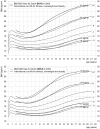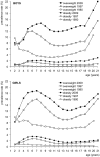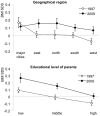Increase in prevalence of overweight in Dutch children and adolescents: a comparison of nationwide growth studies in 1980, 1997 and 2009
- PMID: 22110687
- PMCID: PMC3216980
- DOI: 10.1371/journal.pone.0027608
Increase in prevalence of overweight in Dutch children and adolescents: a comparison of nationwide growth studies in 1980, 1997 and 2009
Abstract
Objective: To assess the prevalence of overweight and obesity among Dutch children and adolescents, to examine the 30-years trend, and to create new body mass index reference charts.
Design: Nationwide cross-sectional data collection by trained health care professionals.
Participants: 10,129 children of Dutch origin aged 0-21 years.
Main outcome measures: Overweight (including obesity) and obesity prevalences for Dutch children, defined by the cut-off values on body mass index references according to the International Obesity Task Force.
Results: In 2009, 12.8% of the Dutch boys and 14.8% of the Dutch girls aged 2-21 years were overweight and 1.8% of the boys and 2.2% of the girls were classified as obese. This is a two to three fold higher prevalence in overweight and four to six fold increase in obesity since 1980. Since 1997, a substantial rise took place, especially in obesity, which increased 1.4 times in girls and doubled in boys. There was no increase in mean BMI SDS in the major cities since 1997.
Conclusions: Overweight and obesity prevalences in 2009 were substantially higher than in 1980 and 1997. However, the overweight prevalence stabilized in the major cities. This might be an indication that the rising trend in overweight in The Netherlands is starting to turn.
Conflict of interest statement
Figures



References
-
- World Health Organization. World Health Assembly resolution WHA57.17 On a global strategy on diet physical activity and health. Geneva: WHO; 2004.
-
- Livingstone MB. Childhood obesity in Europe: a growing concern. Public Health Nutr. 2001;4:109–116. - PubMed
-
- Hirasing RA, Fredriks AM, Buuren van S, Verloove-Vanhorick SP, Wit JM. [Increased prevalence of overweight and obesity in Dutch children, and the detection of overweight and obesity using international criteria and new reference diagrams] Dutch. Ned Tijdschr Geneeskd. 2001;145:1303–1308. - PubMed
-
- Branka F, Nikogosian H, Lobstein T, editors. The challlenge of obesity in the WHO European Region and the strategies for respons. Copenhagen: WHO; 2007.
Publication types
MeSH terms
LinkOut - more resources
Full Text Sources

